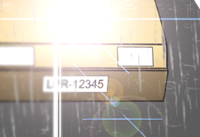Physical surroundings
When you mount and use cameras for LPR, note the following factors related to the surroundings:
Too much light
Too much light in the surroundings can lead to overexposure or smear:
-
Overexposure is when images are exposed to too much light, resulting in a burnt-out and overly white appearance. To avoid overexposure, Milestone recommends that you use a camera with a high dynamic range and/or use an auto-iris lens
-
Iris is the adjustable aperture. For that reason, iris has a significant effect on the exposure of images
-
Smear is an effect from overexposure that leads to unwanted light vertical lines in images. It is often caused by slight imperfections in the cameras’ charge-coupled device (CCD) imagers. The CCS imagers are the sensors used to digitally create the images
Too little light
Too little light in the surroundings or too little external lighting can lead to underexposure.
-
Underexposure is when images are exposed to too little light, resulting in a dark image with hardly any contrast (see Contrast). When auto-gain (see Unwanted camera features) cannot be disabled or when you are not able to configure a maximum allowed shutter time (see Lens and shutter speed) for capturing moving vehicles, too little light will initially lead to gain noise and motion blur in the images, and ultimately to underexposure
To avoid underexposure, use sufficient external lighting and/or use a camera that has sufficient sensitivity in low-light surroundings without using gain
-
Infrared is another way to overcome difficult lighting conditions. You can use artificial infrared lighting combined with an infrared-sensitive camera with an infrared pass filter. Retro-reflective license plates are particularly suitable for use with infrared lighting:
-
Retro-reflectivity is achieved by covering surfaces with a special reflective material which sends a large portion of the light from a light source straight back along the path it came from. Retro-reflective objects appear to shine much more brightly than other objects. This means that at night they can be seen clearly from considerable distances. Retro-reflectivity is frequently used for road signs, and is also used for different types of license plates
-
-
Weather conditions, such as snow or very bright sunlight may for example require special configuration of cameras
-
License plate condition: Vehicles may have damaged or dirty license plates. Sometimes this is done deliberately in an attempt to avoid recognition


